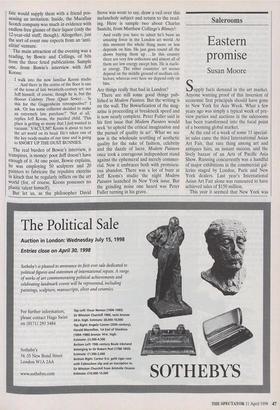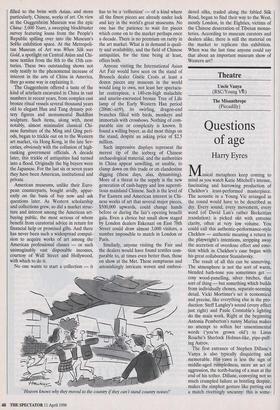Salerooms
Eastern promise
Susan Moore
Supply fuels demand in the art market. Anyone wanting proof of this inversion of economic first principals should have gone to New York for Asia Week. What a few years ago was simply a typical week of pre- view parties and auctions in the salerooms has been transformed into the focal point of a booming global market.
At the end of a week of some 11 special- ist sales came the third International Asian Art Fair, that rare thing among art and antiques fairs, an instant success, and the lively bazaar of an Arts of Pacific Asia Show. Running concurrently was a handful of major exhibitions in the commercial gal- leries staged by London, Paris and New York dealers. Last year's International Asian Art Fair alone was rumoured to have achieved sales of $150 million.
This year it seemed that New York was filled to the brim with Asian, and more particularly, Chinese, works of art. On view at the Guggenheim Museum was the epic China: 5,000 Years, a sweeping blockbuster survey featuring loans from the People's Republic spilling over into the Museum's SoHo exhibition space. At the Metropoli- tan Museum of Art was When Silk was Gold, a spotlight on Central Asian and Chi- nese textiles from the 8th to the 15th cen- turies. These two outstanding shows not only testify to the phenomenal increase of interest in the arts of China in America, they go some way in explaining it.
The Guggenheim offered a taste of the kind of artefacts excavated in China in vast numbers in recent years, from complex cast bronze ritual vessels several thousand years old to elegant Han and Tang dynasty pot- tery figures and monumental Buddhist sculpture. Such items, along with, most notably, almost minimalist classical Chi- nese furniture of the Ming and Qing peri- ods, began to trickle out on to the Western art market, via Hong Kong, in the late Sev- enties, obviously with the collusion of high- ranking government officials. A decade later, this trickle of antiquities had turned into a flood. Originally the big buyers were the Japanese. For the last six or seven years they have been American, institutional and private.
American museums, unlike their Euro- pean counterparts, bought avidly, appar- ently on the basis of buy now and ask questions later. As Western scholarship and collections grew, so did a market struc- ture and interest among the American art- buying public, the most serious of whom benefit from curatorial advice in return for financial help or promised gifts. And there has never been such a widespread compul- sion to acquire works of art among the American professional classes — or such unimaginably vast disposable incomes, courtesy of Wall Street and Hollywood, with which to do it.
No one wants to start a collection — it has to be a 'collection' — of a kind where all the finest pieces are already under lock and key in the world's great museums. No one has the patience to wait for pieces which come on to the market perhaps once a decade. There is no premium on rarity in the art market. What is in demand is quali- ty and availability, and the field of Chinese antiquities, for the time being at least, offers both.
Anyone visiting the International Asian Art Fair would have seen on the stand of Brussels dealer Gisele Croes at least a dozen pieces any museum in the world would long to own, not least her spectacu- lar centrepiece, a 140-cm-high malachite and azurite-encrusted bronze Tree of Life lamp of the Early Western Han period (206Bc-AD9), its swirling, dragon-end branches filled with birds, monkeys and immortals with crossbows. Nothing of com- parable size or complexity is known. It found a willing buyer, as did most things on the stand, despite an asking price of $2.5 million.
Such impressive displays represent the merest tip of the iceberg of Chinese archaeological material, and the authorities in China appear unwilling, or unable, to clamp down on this trade or on clandestine digging (these days, alas, dynamiting). More of a threat to the supply is the new generation of cash-happy and less supersti- tious mainland Chinese. Such is the level of Far Eastern and American interest in Chi- nese works of art that several major pieces, $500,000 upwards, could change hands before or during the fair's opening benefit gala. Even a choice but small show staged by London dealers Eskenazi on East 78th Street could draw almost 3,000 visitors, a number impossible to match in London or Paris.
Similarly, anyone visiting the Fair and the dealers would have found textiles com- parable to, at times even better than, those on show at the Met. These sumptuous and astonishingly intricate woven and embroi- `Heaven knows why they moved to the country if they can't stand count'', noises!' dered silks, traded along the fabled Silk Road, began to find their way to the West, mostly London, in the Eighties, victims of the Chinese desecration of Tibetan monas- teries. According to museum curators and dealers alike, there is still the material on the market to replicate this exhibition. When was the last time anyone could say that about an important museum show of Western art?



































































 Previous page
Previous page